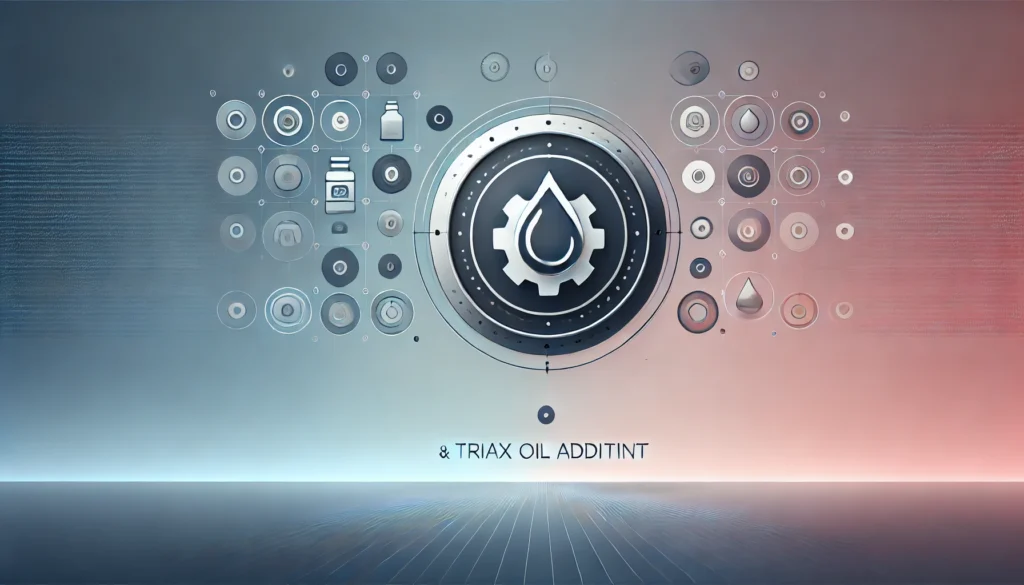Maintaining your engine is essential for optimal performance and longevity. Engine additives can help reduce wear, improve engine health, and extend engine life. With so many products available, one common question arises: can I used Engine Restorer and Triax Oil Additive together? This article dives into the details, exploring whether these two popular additives can work in harmony, their benefits, and the proper ways to use them.
Introduction: Understanding Engine Additives
Engine additives are specialized chemical compounds designed to enhance engine performance, prevent wear, and clean internal parts. While not a substitute for regular maintenance, they offer an extra layer of protection, helping engines run smoother and last longer.
Among the most popular options are Engine Restorer and Triax Oil Additive. Each product serves a distinct purpose, but how do they work together? Understanding their functions is key before deciding to use them simultaneously.
What Is Engine Restorer?
Engine Restorer is a product aimed at rejuvenating older or worn engines. It works by filling in microscopic wear areas in the engine’s cylinder walls, effectively restoring lost compression. This process leads to better fuel efficiency, smoother performance, and reduced oil consumption.
Ideal for high-mileage vehicles, Engine Restorer is especially useful in aging engines where power loss and increased oil consumption are common. It is also compatible with both gasoline and diesel engines, making it a versatile solution for various engine types.
What Is Triax Oil Additive?
Triax Oil Additive is designed to reduce friction, wear, and oxidation in engine oil. It contains advanced friction modifiers, anti-wear agents, and antioxidants, which work together to protect engine components, even under extreme conditions.
Suitable for a range of engine types, including performance engines and commercial vehicles, Triax Oil Additive enhances the lubrication and stability of engine oil. Whether you use synthetic, semi-synthetic, or conventional oils, Triax keeps the oil stable and maintains engine protection over time.
Can I Use Engine Restorer and Triax Oil Additive Together?
Yes, you can use Engine Restorer and Triax Oil Additive together. While each product has different functions—Engine Restorer helps restore compression in worn engines, while Triax Oil Additive enhances lubrication—they are both oil-soluble and compatible with one another.
However, it’s essential to consider proper dosages. Adding too many products to your engine oil may affect its viscosity and performance. Always follow the manufacturer’s instructions and ensure that you’re using the correct amount of each product for the best results.
Compatibility of Engine Restorer with Other Additives
Engine Restorer is generally safe to use alongside other oil additives. It primarily targets the metal surfaces inside the engine, filling worn areas and restoring compression. Combining it with a product that focuses on lubrication or oxidation protection, like Triax Oil Additive, usually results in a balanced approach.
That said, overloading your oil with too many additives can reduce its overall effectiveness. Avoid exceeding recommended dosages and check if the additives are compatible before combining them.
Compatibility of Triax Oil Additive with Other Additives
Triax Oil Additive is compatible with a variety of other oil additives, including Engine Restorer. Its focus on reducing friction and wear makes it complementary to many engine treatments, especially those designed for high-mileage or high-performance vehicles.
When using multiple additives, ensure that you don’t overuse them. Adding too many different compounds can alter your oil’s viscosity and other properties, affecting performance. Always refer to the recommended amounts and avoid exceeding them.
Benefits of Using Engine Restorer Alone
Using Engine Restorer alone can significantly benefit engines that have experienced wear and power loss over time. By filling in the wear points on the engine’s cylinder walls, it restores lost compression, improving fuel efficiency and overall engine smoothness.
For older or high-mileage engines, Engine Restorer helps reduce oil consumption and smooth out rough idling. It also helps bring back some of the lost power, making it a valuable option for vehicles showing signs of wear.
Benefits of Using Triax Oil Additive Alone
Triax Oil Additive, when used alone, provides enhanced lubrication, reduces engine friction, and prevents wear. These benefits lead to smoother engine operation, less noise, and improved fuel efficiency. Additionally, Triax helps maintain oil stability even in extreme conditions, such as high heat or heavy loads.
Whether you drive a performance car, a heavy-duty vehicle, or simply want to extend the life of your engine, Triax Oil Additive offers enhanced protection for your engine components. It’s particularly useful for engines under heavy stress or in demanding driving conditions.
Combined Effects: Engine Restorer and Triax Oil Additive
When you combine Engine Restorer and Triax Oil Additive, you get a full range of engine protection. Engine Restorer focuses on rebuilding worn areas inside the engine, while Triax Oil Additive enhances lubrication and reduces friction. Together, they can restore lost power, smooth out engine performance, and extend the life of engine components.
However, be mindful of the dosages. Using too many additives can dilute the oil’s effectiveness. Ensure that you follow the instructions for both products to achieve optimal results.
How to Use Engine Restorer Safely
Using Engine Restorer is straightforward. Begin by checking your vehicle’s oil level. Based on your engine’s size, add the recommended amount of Engine Restorer, typically one can per 4-6 quarts of oil.
For best results, use Engine Restorer during an oil change. After adding it to your oil, run the engine for several minutes to allow the additive to circulate. Over time, you’ll notice improved performance, especially in older engines.
How to Use Triax Oil Additive Safely
Triax Oil Additive is also easy to use. Before adding the product, ensure your oil level is correct. Then, follow the manufacturer’s recommended dosage, usually a few ounces per quart of oil.
Let the engine run for a few minutes after adding the product. This helps distribute the additive throughout the engine. Avoid overusing the additive, as this could affect oil properties like viscosity. Stick to the suggested amounts for optimal performance.
Factors to Consider Before Mixing Additives
Before mixing additives, consider your engine’s condition. Older engines with reduced power and compression loss may benefit more from Engine Restorer, while high-performance engines could see more advantages from Triax Oil Additive.
Also, verify that your oil is compatible with both products. If unsure, consult your mechanic or review your engine’s manual to confirm compatibility and recommended dosages.
User Experiences: What Car Owners Say
Many drivers have used both Engine Restorer and Triax Oil Additive together with positive results. Users often report smoother engine performance, better fuel economy, and noticeable power restoration, especially in older vehicles.
However, some users advise caution when mixing additives. It’s essential to avoid overuse and maintain regular oil changes to maximize the benefits of these products.
Scientific Basis Behind Engine Restorer
Engine Restorer works by filling in microscopic wear areas inside the engine’s cylinder walls. This process increases compression in engines that have lost power due to wear. The result is improved fuel efficiency and smoother engine performance.
According to research, Engine Restorer can increase compression by up to 75% in worn engines. This leads to reduced oil consumption, better performance, and lower emissions, especially in older or high-mileage engines.
Scientific Basis Behind Triax Oil Additive
Triax Oil Additive’s effectiveness comes from its advanced friction reducers, anti-wear agents, and antioxidants. These compounds work together to reduce metal-on-metal wear, protect engine components, and prevent oil breakdown due to oxidation.
The additive is particularly useful in high-stress environments like towing or performance driving, where engines experience extreme heat and pressure. Research supports that Triax Oil Additive extends engine life, improves efficiency, and maintains oil stability.
Engine Types Best Suited for Additives
Both Engine Restorer and Triax Oil Additive work well with a wide range of engine types. Engine Restorer is most beneficial for older engines, especially those with high mileage or showing signs of wear, such as increased oil consumption or loss of power.
Triax Oil Additive is ideal for high-performance engines, commercial vehicles, and engines that endure extreme conditions. It’s effective in both newer and older engines and works with gasoline, diesel, or hybrid engines.
Signs Your Engine Needs Restorer or Additive
If your engine shows signs of wear, such as reduced power, increased oil consumption, or rough idling, Engine Restorer may help. These issues often indicate reduced engine compression due to wear.
On the other hand, if you hear engine noise, notice increased friction, or see reduced fuel efficiency, Triax Oil Additive could be beneficial. It improves lubrication and reduces wear in engines exposed to high stress.
Risks of Using Too Many Additives
While additives provide many benefits, overusing them can have negative effects. Too many additives can alter your oil’s chemical composition, reducing its effectiveness. For instance, excessive use of friction modifiers can thicken the oil and impair its ability to lubricate engine parts.
Deposit buildup inside the engine can also result from additive overuse, potentially clogging oil passages and reducing performance. Always follow recommended dosages and consult a mechanic if you’re unsure.
Manufacturer Recommendations for Engine Additives
Most car manufacturers recommend using high-quality engine oil and additives only when necessary. Overuse of additives can lead to issues such as warranty voidance or conflicts with the vehicle’s specifications.
Before using aftermarket additives, consult your vehicle’s owner’s manual or a professional mechanic. Make sure the additives are compatible with your engine, oil type, and manufacturer guidelines to avoid any complications.
Conclusion: Is It Safe and Effective to Use Engine Restorer and Triax Oil Additive Together?
Yes, using Engine Restorer and Triax Oil Additive together is generally safe. Engine Restorer focuses on restoring lost compression in worn engines, while Triax Oil Additive enhances lubrication and protects against wear. These two products complement each other well when used in the right amounts.
Be sure to follow the recommended dosages for both additives to avoid overuse, which can affect your oil’s performance. When applied properly, these products can significantly improve your engine’s performance, extend its life, and help it run more smoothly.


